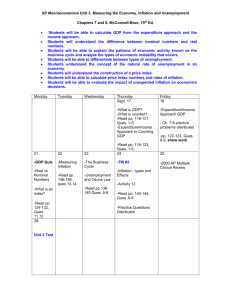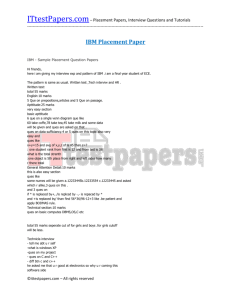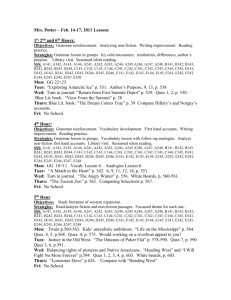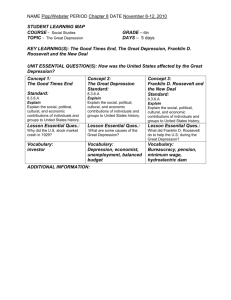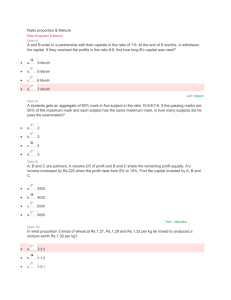Week # 1 Homework doc
advertisement
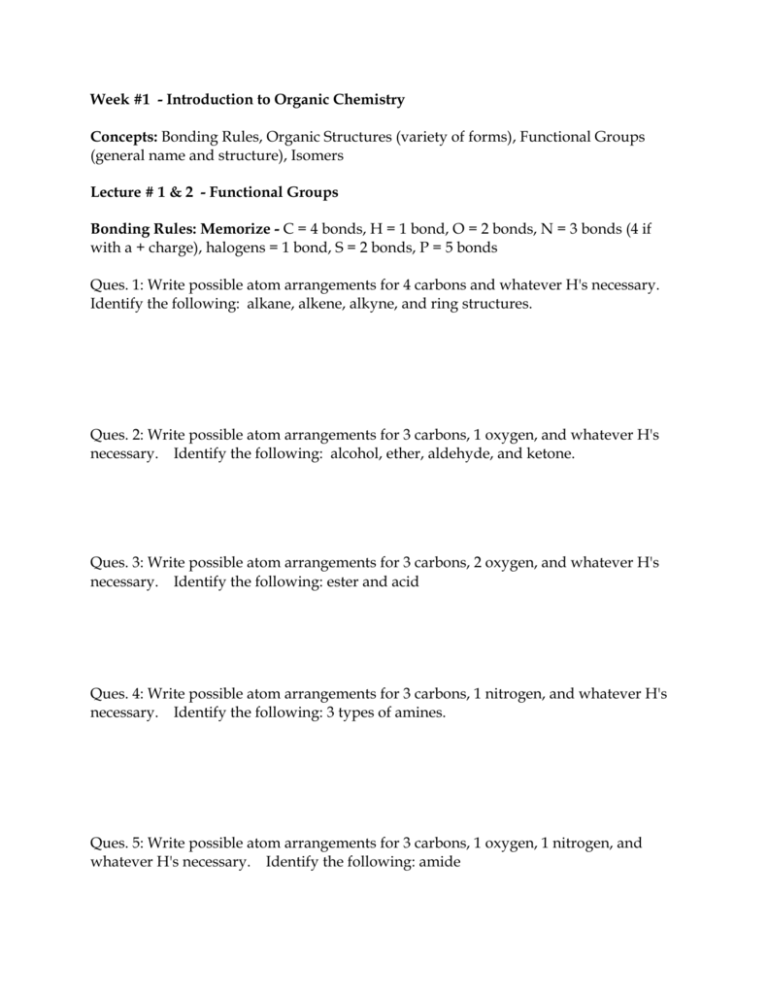
Week #1 - Introduction to Organic Chemistry Concepts: Bonding Rules, Organic Structures (variety of forms), Functional Groups (general name and structure), Isomers Lecture # 1 & 2 - Functional Groups Bonding Rules: Memorize - C = 4 bonds, H = 1 bond, O = 2 bonds, N = 3 bonds (4 if with a + charge), halogens = 1 bond, S = 2 bonds, P = 5 bonds Ques. 1: Write possible atom arrangements for 4 carbons and whatever H's necessary. Identify the following: alkane, alkene, alkyne, and ring structures. Ques. 2: Write possible atom arrangements for 3 carbons, 1 oxygen, and whatever H's necessary. Identify the following: alcohol, ether, aldehyde, and ketone. Ques. 3: Write possible atom arrangements for 3 carbons, 2 oxygen, and whatever H's necessary. Identify the following: ester and acid Ques. 4: Write possible atom arrangements for 3 carbons, 1 nitrogen, and whatever H's necessary. Identify the following: 3 types of amines. Ques. 5: Write possible atom arrangements for 3 carbons, 1 oxygen, 1 nitrogen, and whatever H's necessary. Identify the following: amide Ques. 6: Identify the functional groups in the following structures: Ques. 7: Identify the functional groups in the following structures: Ques. 8: Identify the functional groups in the following structures: Ques. 9: What are the general properties of organic compounds vs. inorganic compounds? Bonding Polarity - Melting and Boiling points Solubility in water - QUES. 10 : Functional Groups - Structures and Molecular Geometry Name Structure Examples & isomers Geometry Alkanes C-C (all single bonds) C4H10 Alkenes C=C (double bonds) C3H6 Alkynes C C C3H4 (triple bonds) Alcohols C-OH Thiol and Disulfides C-SH C-S-S-C Ethers C-O-C Aldehydes O C4H10O C4H10S C4H10S2 C4H10O C4H8O HC H Ketones O C4H8O R-C-R Acids O C4H8O2 R - C - OH Esters O C4H8O2 R - C - OR Amines C3H9N (three types) R-NH2 Amides O R - C - N-H2 C3H7NO (two types) 3-D Structure Salts O R - C - O -M+ Hemiacetal & Acetal C4H7O2-M+,C3H10N+A- O R - C - N-H3+A- C4H10O2 OH H2C O CH3 H2C O CH3 O CH3 Week # 1 - Lecture # 3 - Nomenclature - How to Name Organic Compounds Memorize root names of alkanes associated with the number of carbons present: 1 = methane; 2 = ethane; 3 = propane; 4 = butane; 5 = pentane; 6 = hexane; 7= heptane; 8 = octane; 9 = nonane; 10 = decane. WRITE NAMES, given the structure 1. Root Name: Identify the longest continuous carbon chain and assign a root name. (A ring requires the prefix "cyclo-". 2. Functional group: Identify the functional group and determine the appropriate ending for the root. 3. Number the carbons, so that the carbon with the functional group (or branch) will have the lowest number. In front of the root name, write the position of the carbon with the functional group, if necessary. WRITE STRUCTURES, given the name 1. Root Name: Write the number of carbons according to the root name (A ring is indicated by the prefix "cyclo-". 2. Number the carbons: Assign a number to each carbon of the root (most of the time - left to right) 3. Functional group: Write the functioinal group as indicated by the endingof the rootname at the appropriate position. (Indicated by the nature of the functional groups or the position number given front of the name. 4. Hydrocarbon Branches: Identify and 4. Hydrocarbon Branches: Write any write any hydrocarbon branches with "-yl" hydrocarbon branches at the appropriate endings and their position numbers, if any. position number, if any. 5. Inorganic Groups: Identify and write any 5. Inorganic Groups: Write any inorganic inorganic groups and their positions, if any. groups at the appropriate positions, if any. 6. Final Name: In the names, hyphens 6. Complete the structure by adding the separate numbers and names; commas appropriate numbers of hydrogens to each separate two or more numbers, and word carbon. (Carbon must have four bonds) parts are NOT separated except in ethers and esters. QUES. 11 - Functional Groups - Structures and Nomenclature Name Alkanes Alkenes Structure Examples & isomers Name Ending C4H10 Root name C3H6 -ene Alkynes C3H4 -yne IUPAC Name Alcohols C4H10O -ol Thiol and Disulfides C4H10S C4H10S2 Ethers C4H10O Aldehydes C4H8O -thiol, disulfid e -yl ether -al Ketones C4H8O -one Acids C4H8O2 -oic acid --yl Esters C4H8O2 Amines C3H9N (three types) -oate -yl amine Amides C3H7NO (two types) -yl Salts C4H7O2-M+,C3H10N+A- amide -ate, ammon ium Ques.12. COMMON COMPOUNDS AND USES For all compounds which follow, write the name or structure, whichever is missing. IUPAC NAME STRUCTURE COMMON NAMES/USES a. Propane If liquefied, called LP gas b. Trichloromethane Chloroform; solvent, general anesthetic c. Chloroethane d. Tetrachloroethene e. HC C-H f. H2C = CH2 g. CH3OH h. CH3CH2OH i. 2-propanol j. Local anesthetic for minor surgery (freeze technique) Dry cleaning fluid, metal degreasing Acetylene; combustion produces hot flame for cutting and welding steel Ethylene; plasticpolyethylene, raw material for many organic reactions Methyl alcohol or wood alcohol, basic raw material, can cause blind Ethyl alcohol, grain alcohol, alcohol, sprits Isopropyl alcohol, rubbing alcohol, hand lotions, after shave lotions CH3CH2-O-CH2CH3 Ether, anesthetic k. HCOOH Formic acid, sharp smelling liquid responsible for sting of certain l. CH3COOH Acetic acid, vinegar m. Butanoic acid Odor of rancid butter n. Hexanoic acid Caproic acid, smell of goats o. Methyl butanoate Scent of apples p. Butylbutanoate Pineapple essence q. Ethyl butanoate Artificial peach flavor r. Ethyl ethanoate s. t. methanal (CH3) 2NH Ethyl acetate, nail polish remover Constituent in herring brine-used to manufacture fungicides and rubber Formaldehyde, formalin, preservative for biological specimens, basic raw material Acetone, basic raw material, solvent, diabetics produce Solvent for lacquers, finger nail polish Acetaldehyde, paraldehyde, hypnotic and sedative, basic raw material u. 2-propanone v. butanone w. ethanal Ques. 13: Write the IUPAC name of each of the following: Ques. 14. List the number of allowable bonds for: H, N, O, C and Cl. Ques. 15. Write the structures for compounds with 5 carbons and the correct number of O, H, and/or N for: acid, amine, aldehyde, ketone, ester and ether. Ques. 16. Write the general name for the functional group in the following compounds and write the IUPAC name for each. a) CH3CH2COOH b) CH3-O-CH2CH3 c) CH3OH d) CH3CCCH3 e) CH3CH=CHCH3 f) CH2CH2 NH2 Ques.17. A compound contains 5 carbons and one “double bond oxygen”. The oxygen is not on an “end” carbon, but there are equal numbers of carbons on either side of it. What is the structure of the compound? Ques. 18: Write the IUPAC name of each of the following: Ques. 19: Write the IUPAC name of each of the following Ques. 20: Write the IUPAC name of each of the following: Ques. 21: Write the IUPAC name of each of the following: Ques. 22: Write the IUPAC name of each of the following: Ques. 23. Name the following compounds: CH3 H3C CH3 H2C H2 C C H2C H2C C H2 CH3 H2 C CH OH CH C H2 CH3 H2 C H C H3C CH2 CH2 C H H3C H3C CH2 C CH2 CH CH3 Ques. 24. Write a structure for each of the following: a) 1-heptyne b) 2-methylpropanal c) 3-ethyl-3-methylhexanoic acid d) 5-isopropyl-1-nonanol CH3 e) 2,3,5-trimethyloctanal f) ethyl propanoate

